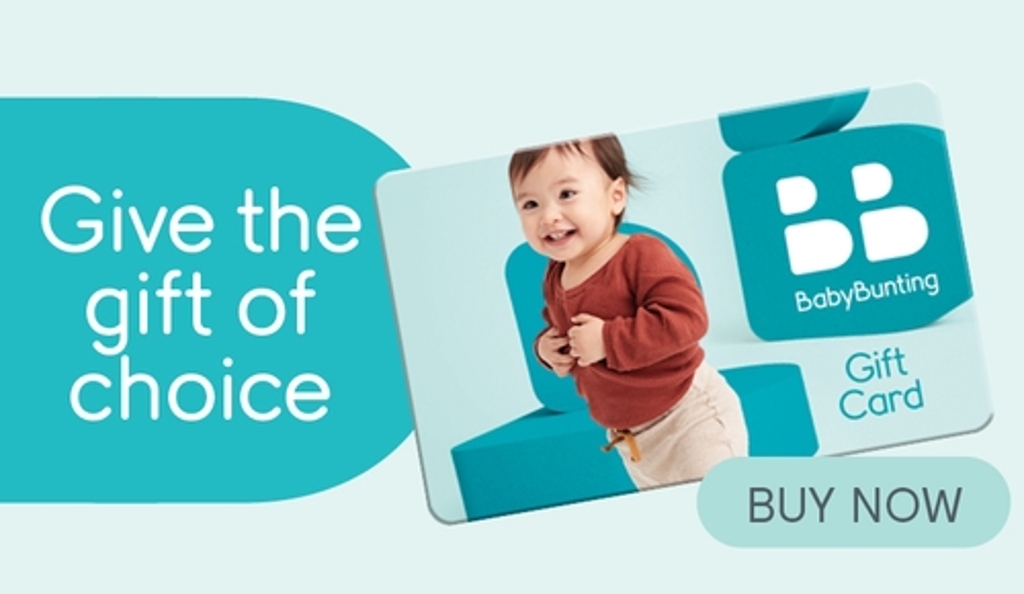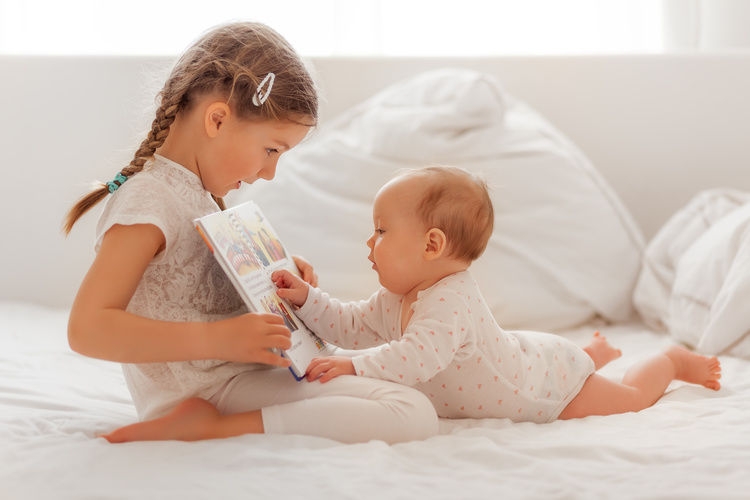Does reading to babies help?
Your baby’s brain is learning to understand language before they’re even born. While your little one might not speak their first word until they’re 12 months or older, they’re always listening, and the cogs are already turning to learn how to talk. Reading to your infant is a great way to help develop their speech and communication skills.
Not only are books and stories great for language development, reading time can be a great time to bond with your little one as you jump into fantastical and fictional words.
Stories spark children’s imagination. Though your little one may not comprehend the story as it is, being read to can encourage curiosity and help them become more familiar with sounds, sentence structures, and word patterns. Storybooks can also help teach your baby the difference between ‘real’ and ‘make-believe.’
And that's not all! Reading may help improve valuable life skills, such as vocabulary, memory, concentration and empathy. And once your little one is old enough, books are great practice for fine motor skills. Picking up and holding pages helps develop the grasping and gripping reflex while turning pages helps your little one learn how to pinch.
As your little baby grows, all these pre-reading skills will serve them well. By the time your little one starts school, they'll already understand that letters make words and reading goes left to right. Reading to your little one is a great way to connect, learn, and support your little one as they grow.
Are you wondering when to start reading to baby at bedtime and what you should be reading? There are children's books for every age, stage, and interest, so don't worry - there's plenty of options out there!
What should I read to my infant?
Picture books are a great way to keep your little one visually stimulated and engaged. Babies can best see bright colours or high-contrasting black and white images. Try putting your little one on your lap or have the book turned to them so they can enjoy the pictures as you read to them.
Stories are also a good way to familiarise your little one with the things they’ll encounter in the world. Popular children’s books are often about food, animals, transport, or other children. Interactive books with lift-up-flaps, pop-ups or different textures on the page are great for developing senses and starting conversations as you explore each little surprise with your baby.
When choosing a book to read, look for books with repetition and rhymes. These elements can help babies understand language patterns and develop the concept that the story is the same every time you read it. Hearing sounds and words repeated while watching the way your mouth moves are all good for infant speech development.
Not everyone loves kid's books though, and that's OK! If you're an avid reader, bring your baby along for the experience. Sharing stories you love by reading them aloud to your little one is a great way to share your passion for reading, and they'll still enjoy all the amazing benefits that come with hearing the cadence and expression of your language.
How does age affect the books you should read to your little one?
Stories are an important part of healthy child development. Whether these stories are delivered via the written word or orally, stories play a critical role in language development, knowledge-sharing and imparting life lessons. Although it may seem intuitive upon reflection, stories and books change as your baby, toddler or child grows. These changes mirror and mark key stages in your child’s development and learning.
Books for babies
Books for babies are usually simple, full of contrasting colours and may feature different textures. Since babies learn language through observation, the experience of seeing and feeling helps your little one build up a series of connections between stimuli, context, intent and meaning.
Baby books tend to focus on simple objects, characters and colours. They may feature different textures or the book itself may be an interesting shape.
As you read to your little one, remember that the experience of reading a book is as important as the content of the book itself. Babies respond to the physical act of sitting down and reading with you. They may also enjoy listening to your voice when you read along, sing or rhyme.
Books for toddlers
Stories for toddlers often introduce a range of everyday objects and processes. This mirrors your toddler’s increasing contact with the world and their ability to manipulate objects in the world. Books may have additional complexity, such as different moving parts and pictures that are hidden under flaps.
Subjects of books for toddlers often include a character experiencing a range of different things, such as types of food, animals or household objects. These books may also depict experiences that are familiar to your toddler, such as playing in the bath, going to the park or cleaning the house. These stories provide an opportunity for your toddler to expand their vocabulary. Reading stories that mirror their own life will give your little one the chance to compare reality and fiction while giving them a way to contextualise the language in the story.
Beyond understanding the world around them, books for toddlers will also help with educational development. Concepts such as basic counting may be introduced, and your toddler may be able to recognise words and say them aloud. These books will help prepare them for school.
Books for young children
Books for young children often revolve around social situations, fantasy and humour. One of the core aspects of books for young readers is that they introduce characters navigating social situations. This is a way of reflecting the experiences your child may be having in their own life, and it helps to create understanding, empathy, and give words to emotions. These books may focus on how to treat people, look after animals, stay safe in situations and protect the environment.
Your child may be able to read parts of or the whole book at this point. Even if they’re not reading fully, they will soon be able to make the connections between the pictures and spoken words. Your child may ask you questions about why characters did this, or how they did that. You can also ask your child questions about the characters to encourage their imagination and empathy.
Often humour and fantasy make their way into books for preschoolers and young children, with animals, monsters or dinosaurs standing in for humans. Nevertheless, the characters remain clearly identifiable, and their depicted experiences – like their first day at school – are comparable to real life.
Children may also take the characters out of the stories and imagine their own narratives for the characters. They can do this by extending and projecting the story beyond what they saw on the pages, depicting the characters through art or by using their toys to construct experiences of their own for the characters. As they imagine their own narratives for characters, take interest in their re-imaginings to encourage further creativity.
Children and non-fiction books
Some children are fascinated by understanding the world around them. They may equally enjoy or even prefer non-fiction books to fiction books. Books about the world that include animals, dinosaurs, machines, the human body and outer space are a natural extension to their curiosity that began as a toddler.
It’s entirely normal for some children to almost obsess over a subject. Most of the time this is a phase, but sometimes this fascination can extend into adolescence and – in some cases – may even lead into a lifelong passion or career.
How to read to your baby, toddler & child
In addition to picking the right books for your little one, you also want to make sure you’re reading to your little one in the best way. Some of our reading tips include:
Set aside the time each day to sit down with your baby, toddler or child and read a book together. This will help your little one get familiar with a reading routine.
Minimise any distractions - turn off the TV and leave your phone in another room, if you can. Without distraction, you and your little one can focus on both the sounds of the words and the story itself.
Try to arrange your position so that there is an imaginary triangle between yourself, your child and the book. This allows your child to see your facial expressions and observe how your mouth forms sounds.
Try and read in the same quiet, comfortable place each day so that your little one’s attention is focused. If possible, have a bookshelf close by to encourage your child to continue reading if they choose.
5. Story time can play part of your pre-bedtime routine ritual, and it can be a handy way to reduce screen time before bed and relax before sleep.
6. If your little one doesn't like to sit still long enough to listen to a whole (or any) story, that's OK! Set yourself up nearby, pick a book you enjoy, and read aloud. Your little one will likely be listening, even if they don't appear to be, and every story they hear is helping build all those brain connections.
What makes a good book for babies?
Once you’ve found a book within the right age range, it’s time to start looking at what makes a book good for babies. Books with bright colours or simple, large and high-contrast pictures are interesting and easy for babies to focus on. You can also look for books with different textures so your baby can hear, see and feel the book. Waterproof plastic and cloth books make great books for babies since they can go in your little one’s mouth without getting damaged. Books that are easy to clean (like board books) are great for younger babies and will be your go-to when reading to your little one.
For older toddlers and children, they will help you know what a good book is because they will want to read it over and over again. Kids who repeatedly pick up the same book enjoy the feeling of knowing what’s coming.
Book recommendations from Baby Bunting
There are plenty of books that we love at Baby Bunting and think would be good for your little one to read, from books for babies to young readers.
Where is the Green Sheep by Mem Fox
Where’s Spot by Eric Hill
Ten Little Fingers and Ten Little Toes by Mem Fox
We’re Going on a Bear Hunt by Michael Rosen
Hello Baby by Mem Fox
Lamaze Counting Animals Book
Hairy Maclary & Friends: a Touch & Feel Book by Lynley Dodd
Kissed by the Moon by Alison Lester
Fuzzy Yellow Ducklings by Matthew Van Fleet
Just Like My Daddy by David Melling
The Very Hungry Caterpillar by Eric Carle
Ten Little Owls by Renee Treml
Reading with your little one can play a key role in their mental, emotional and physical development. Since stories are so important for language development and knowledge sharing, look for stories that cover a wide range of topics and people. You can discover a wide range of books for your little one at Baby Bunting that will have you exploring new worlds from the comfort of your little one’s reading nook.
Happy exploring!



